When LGBTQ+ rights activists took to the streets for Britain’s first Pride march in 1972, some knew they were making history; others saw it as just another protest. The Gay Liberation Front (GLF) – the pioneering movement behind Pride – was, after all, extremely busy: it organised regular theatrical performance protests known as “zaps”, as well as queer picnics in the park, and revolutionary same-sex dances. Certain things about Pride 72 do stand out in the memory, however: the formidable number of police, the shocked faces of onlookers, and the after party, which involved dancing naked in Hyde Park.
Fifty years on, says activist Ted Brown, people call it Britain’s first official Gay Pride, but there was nothing “official” about it. Pride 72 was not endorsed by the government, let alone the brands and corporations you might see at Pride today. It was not about rainbow flags or pop stars performing; it was fundamentally grassroots, and a challenge to society. Just five years after Britain’s partial decriminalisation of homosexuality in 1967, sex between men under the age of 21 was still banned, and displaying same-sex romantic affection in public was illegal. To take to the streets and show your face to the world was both radical and defiant.
Alongside gay men, trans women marched that day, as well as bisexual people, lesbians and drag queens. Today, when anti-LGBTQ+ hate crime has doubled over four years, and certain groups wish to separate the “LGB” from the “T”, the fight for protection, unity and pride that GLF started continues. In fact, many GLF members are still doing this work themselves. “Meeting up was remarkable,” says Brown, of the reunion of GLF members who were there in 1972. “Some of us hadn’t seen one another for 30 years. But it was also inspiring, because everyone is still speaking out, still active.”
The roots of Pride
It was like a match tossed into a fireworks factory
Ted Brown, activist I went to my first GLF meeting in 1970. I had been given a flyer outside the cinema where I had been to see The Boys in the Band, a controversial early gay film. On my way to the London School of Economics (LSE), I had the rather embarrassing experience of asking people where to find the meeting of homosexuals. They were totally bemused.
Peter Tatchell, human rights campaigner In the summer of 1970, two London students, Bob Mellors and Aubrey Walter, had travelled to the US, where they learned about the gay liberation movement in New York. When they returned to London, they called a meeting of 19 people in the basement of LSE on 13 October 1970. They collectively formed the GLF in Britain.
Brown We were very influenced by the American gay liberation movement, which started after the uprising at the Stonewall Inn, a bar catering to LGBTQ+ people in New York. On 28 June 1969, people started throwing stones at the police during a raid, and general tumult erupted. Apparently, somebody shouted: “Gay power!”
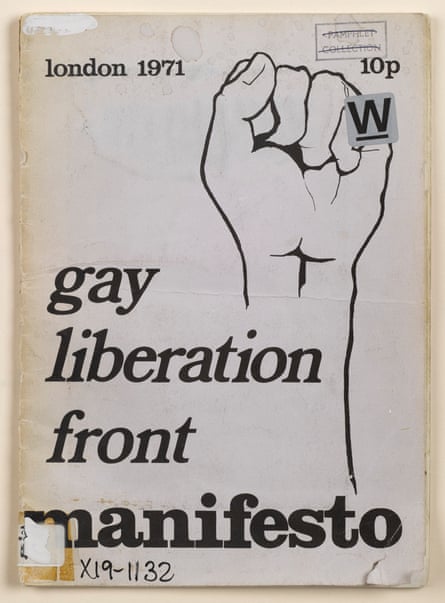
Tatchell My first GLF meeting was in September 1971. I saw a sticker on a lamp-post on Oxford Street. I’d been in London for five days; I’d come from Melbourne, where there were no LGBTQ+ groups. When I walked into the meeting, I felt an immediate sense of camaraderie and solidarity. GLF’s aim was to turn queer people from victims to victors; we thought our homophobic society was the problem, not homosexuality.
Tom Robinson, musician and radio DJ It was like the big bang. This mass potential had been tightly balled up and contained, full of energy inside. The 60s was a decade of liberation for many – but our generation of LGBTQ+ kids still felt shunned and shamed. The message of gay liberation arrived like a match tossed into a fireworks factory.
Brown I had moved to Britain in 1959 from America, where my mother had been a civil rights campaigner, and there were similarities between the two movements. Bob and Aubrey had heard that Huey P Newton had said the Black Panthers should work with the gay movement and the women’s movement. That galvanised GLF to be intersectional before there was a word for it. At my second GLF meeting, I stood up and talked about being black and gay, and dealing with both of those prejudices.
Tatchell The black civil rights movement had the slogan “Black is beautiful”. “Gay is good” was GLF’s version of that.
Mair Twissell, artist I was living in Notting Hill with my husband and small child when I first discovered GLF. We had come from Wales. I was a painter and had been going around all the galleries in London and got very angry that there were no women shown. Then I heard about the 1970 Miss World protest on the radio. I went to the woman living downstairs and said, “Can you babysit for me?” then put on my coat and rushed to the Royal Albert Hall. When I got there, all these women were shouting, “Down with patriarchy”, and I joined in. I was grabbed by police and put in a black van. During the trial, I went to see my friend Nicholas, who was a ballet dancer. There were all these men at his flat who had practically nothing on, covered in sequins and boas. I told him about the court case. He said: “We’re the Gay Liberation Front – we’re supporting the women in the trial, we’re going to do an alternative Miss World to show different types of women.” It was so exciting and so colourful.
Tatchell GLF celebrated gender nonconformism. We challenged traditional gender roles. At the 1971 Miss World, trans people and drag queens from GLF turned up wearing sashes that said things like “Miss Used” or “Miss Represented”. There was also a bloodied “Miss Ulster – The Irish Bombshell” to protest the war in Ireland.
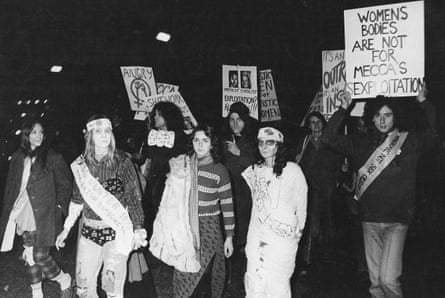
Twissell GLF was a chaotic mix: anarchists, hippies, artists, writers, poets, feminists, leftwingers, liberals. They came from all walks of life. What was so wonderful was that they were so enthusiastic. They believed we could make the world a better place.
Andrew Lumsden, activist It wasn’t for everyone. At least one of my friends refused to go along because he couldn’t be bothered with politics between gay people. Then somebody said to him, “You know there’s a lot of very attractive men at those meetings”, and next time, he was there!
Nettie Pollard, activist I had tried being in the Young Communist League and CND, but neither suited me. I didn’t like labels, but I thought I was a heterosexual when I joined GLF – a rather unsuccessful one. Then I learned better; I started a lesbian relationship in 1972, and never looked back.
Roz Kaveney, author and poet I started going to GLF meetings in autumn 1971. I was living in Oxford at the time. I would occasionally appear at parties cross-dressed, but I was very much passing as a boy. One day at the British Museum in London, I decided to call the GLF number, which I had got from a gay newsletter. I asked if there was a trans group and they said there was: the Transvestite and Transsexual Group.
Robinson “Gay” then was a word used very much like the modern reclaiming of the word “queer”. It meant not just what we mean today – homosexual men – but homosexual, lesbian, bisexual, transgender, non-binary, non-monogamous and, crucially, their friends. It was an all-embracing term.
Kaveney There was a core group of about seven of us trans people, and others who came and went. I think you’d have described most of us as gender questioning – we were not quite sure whether we were cross-dressers or trans. We were still trying to work out who we were, because there was a medical model for being trans that was very binary, very policing, very reactionary.
Tatchell There had been earlier LGBTQ+ movements in Britain, like the Homosexual Law Reform Society, but GLF had a much wider agenda: to take on not only the government but also the church, media, armed forces, the police and education system, and the medical and psychiatric professions. We backed the black community, trade unions under Tory attack, anti-Vietnam war protests and the Troops Out [of Ireland] movement. There were gay rights protests prior to Pride, too.
Brown One of our main demonstrations was in Highbury Fields, London, in November 1970 – a specific challenge against the arrest of Louis Eakes, who had been arrested for “importuning” in the area, and the use of undercover police officers entrapping gay men.
Tatchell In late 1971, we were informed that a pub in west London had refused to serve queers, so we staged a sit-down protest. About three van-loads of police arrived and dragged us out into the street. Another time, a group of trans women from GLF were refused service in a cafe in Piccadilly Circus. We rallied to support them and got the manager to back down.
Brown GLF’s Youth Group also organised a march to Trafalgar Square against the unequal age of consent. For heterosexual couples, it was 16; for same-sex male couples, it was 21. If you were over 21, you were permitted a certain amount of male-to-male contact, in private.
The first Gay Pride in Britain, July 1972
Some people just gawped in disbelief
Stuart Feather, author and activist The age of consent march was a great success, so GLF decided to hold a Gay Pride march in 1972.
Tatchell We came up with the idea of calling it Gay Pride – possibly the first event in the world to use that title. It was a riposte to the idea that as LGBTQ+ people we should be ashamed.
Brown A year after Stonewall, on the anniversary of 28 June, the gay community in New York held the Christopher Street Liberation Day, which later came to be known as their first Pride.
Twissell At that time, there were men who were afraid of coming out; men taking their own lives because they were gay, afraid to tell their families.
Tatchell Most LGBTQ+ people were closeted. Shortly before Pride 72, we went to Earl’s Court, west London, to leaflet gay pubs and encourage customers to join us on the march. We got quite a hostile reception from some of the gay men there. That showed the amount of internalised homophobia.
Feather By 1 July 1972, GLF was also beginning to break up …
Twissell Little cracks started appearing, tensions.
Pollard It was getting bigger, and men were competing for the platform, talking about their experiences, about the age of consent, or cottaging. Women were in a minority, and didn’t like the fact they weren’t given a chance to speak. Women didn’t have anything like we have now – more equal pay, anti-discrimination rights. They were dependent on men, so it was very difficult for them to be lesbians, to lead an open lifestyle and keep their children.
Brown People in GLF carried the attitudes of general society, including some elements of racism. I experienced it. It wasn’t malicious racism but patronising racism.
Feather The women left and formed the Gay Women’s Liberation. So on the day of the first Pride, they came to Trafalgar Square as that, with their own banner, wearing face-paint – warpaint, in a way. They had invested two years of their life in GLF and this was a demonstration and a party – they were keen to be part of it. They had earned their place.
Pollard There were a lot of women there – a lot marching with Gay Women’s Liberation and the Campaign for Homosexual Equality.
Kaveney Someone told me about Pride, and so I told other people. It was all word of mouth.
Lumsden If you happened to know someone who was gay and seething with rage in Glasgow, you’d call them up and say: “Oi, get down here as soon as you can!”
Kaveney I came down on the coach from Oxford. I was just coming up to my 23rd birthday. I can’t remember much except what I was wearing: oxblood-red platforms, purple paisley hot pants with a bib. Very embarrassing.
Feather I would have been in drag. I’d definitely have had eye makeup on, painted nails, a handbag, and some frock or other.
Lumsden I was working on Fleet Street at the time and so I decided that my act, as it were, was to represent ordinary office staff – the forcibly closeted. So I wore a jacket, tie and flannel trousers.
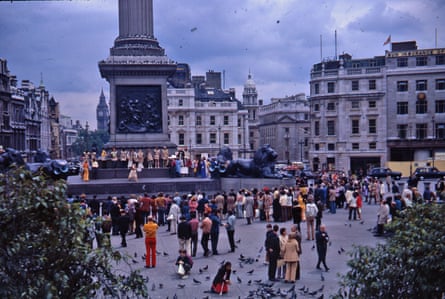
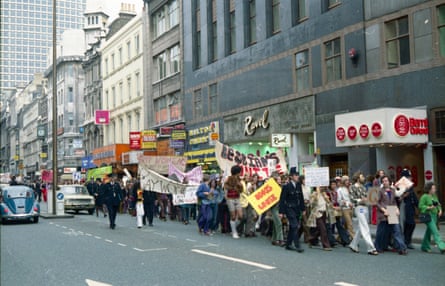
Kaveney What I was wearing was clothing, not a costume. I was someone who, even when I was presenting male, would get roughed up for being queer, or if you were in the street cross-dressed at that time, the police would pick you up for soliciting. Pride felt like safety in numbers.
Tatchell The route went from Trafalgar Square to Piccadilly Circus, Shaftesbury Avenue, Charing Cross Road and Oxford Street to Speakers’ Corner at Hyde Park.
Feather We were having a good time among ourselves, and by responding to the bystanders – some who hated the sight of us and others who were mimicking us, which was great, because we could mimic them back stronger and better than they could.
Pollard There were lines and lines of police watching us. We would chant, “Two, four, six, eight, is that copper really straight?” and, “Three, five, seven, nine, lesbians are mighty fine!” or, “Give us a g-a-y! And what is gay? Good. And what else is gay? Angry!”
Lumsden There were some lovely, funny banners – like “We are the people your parents warned you against”.
Tatchell Some officers made homophobic remarks, but most didn’t.
Twissell Oh, it was frightening. I had to put on a brave face – there were so many police. Lots of people didn’t go on that first Pride march because they were too scared, and I don’t blame them. Walking with a wall of police on each side of you – it’s intimidating.
Brown They might have protected us from counter-protesters. I found them quite respectful that day. I remember thinking: “Thank God this isn’t the American police.”
Lumsden A lot of people, including the police, did not understand the meaning of the word gay. They thought it meant jolly or funny. Members of the public might have thought this was a student rag. There were one or two press at the march, but there wasn’t a battery of Fleet Street photographers. I don’t know if we notified any newspapers. Why bother? They were notoriously homophobic.
Tatchell I would say that about a third of the public who saw the march were, to varying degrees, unsympathetic or hostile. A lot of glowering. Some shouted abuse. About another third just gawped in disbelief that LGBTQ+ people would dare show their faces in public. Another third was supportive, gave a thumbs up, clapped, shouted out things like, “Good on ya.”
Brown It was a civil rights issue for me: it was about letting people know black people can be gay.
Feather As soon as we got to Marble Arch we had organised a kiss-in, and so people started coupling up and snogging. The police left, because they couldn’t stand the sight of that. Then we ended up in Hyde Park. I remember clouds of marijuana smoke, probably people tripping, and party games.
Tatchell People brought food, musical instruments, dope. We played spin the bottle.
Lumsden I remember dancing naked in Hyde Park, which seemed like a perfectly acceptable thing to do that afternoon. About 12 of us did, shoving our clothes under some bushes. It was spontaneous, not a protest. We thought: “Oh, come on, let’s go for this!”
Tatchell Overall, I would say there were about 700 people on the march.
Lumsden Everyone’s idea of numbers varies, but every single person there had begun to change how they felt about themselves, and to reject what society said about us. There were other groups that fought to change the laws that affected all queer people. GLF was about changing ourselves. This was many hundreds of people out in the streets who had broken through that barrier. And that was the way to change the world.
Kaveney Pride was an occasion to be totally oneself in public, with a lot of other people doing the same thing. Not apologising or trying to avoid being noticed. It was freedom.
Lumsden The thinking was: if I come out, I could affect anything up to a dozen other gay people, and if you come out you would astonish or infuriate another 20 people. That it would ripple outwards. And it did. I think we were all, in one way or another, conscious that what we were doing was historic.
Twissell I didn’t realise it was going to be as significant as it became.
The aftermath – and a vital legacy
There was a point where Pride got horribly commercial
Brown: By Pride 73, the splits between factions had grown deeper. There were questions over whether some people in GLF were being too conventional. During 1973, some thought that we should be more transgressive in our clothes – to destroy the gendered ethics we were all brought up with. After Pride 73, GLF split into various action groups and stopped having collective meetings.
Feather By 1974, GLF was completely over.
Pollard I think the separation of men and women had weakened it.
Kaveney People started saying [to the trans women]: “Are you sure you belong here?” Saying: “We think it’s controversial, your identity”, “You’re not authentic.”
Twissell I felt sad, really sad – a sense of loss. We thought it was going to go on for ever, like a huge family. When the women met separately, it didn’t feel right. I liked it as it was. I used to visit the lesbians and the bisexuals – there were a lot of bisexuals in GLF – and at one point afterwards some said they had become lesbian feminist separatists. I thought: “I don’t want to be in this.”
Brown By 1973, I don’t think there was anyone in England who hadn’t heard of GLF. We had succeeded in making people proud of who they were. So there was a belief by some that we should go out and live our lives – that there was no need to have GLF any more. It kind of fizzled. But most of us remained in contact. I lived in a GLF commune for another two years.
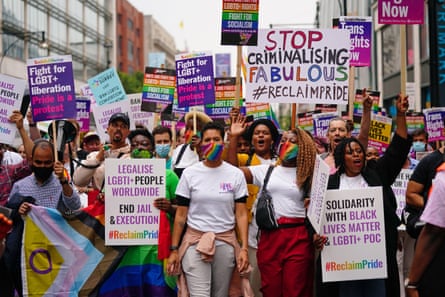
Robinson There were still Prides afterwards. I wrote the song (Sing If You’re) Glad to Be Gay for the rally in 76. There were still GLF dances for years, too. When the movement exploded and everybody fell out with each other, as all left-leaning movements tend to, some former GLF people founded the Lesbian and Gay Switchboard helpline, and the newspaper Gay News. They were very much inspired by its energy, its can-do approach.
Lumsden There was one year [1981] when Huddersfield had been encountering hostile police behaviour and sent an appeal to London activists. At once, London surrendered its Pride and took it to Huddersfield.
Kaveney: I remember lovely Prides in the 80s in Jubilee Gardens on the South Bank, or south London parks. But there was a point where Pride got horribly commercial: when it took over Finsbury Park and you had to buy various coloured armbands to get into things. It excluded a lot of people. And for those of us who had been around in the early days, it just felt wrong. I preferred it when it was cheap and cheerful.
Tatchell I’ve marched in every single London Pride since 1972, and over the decades LGBTQ+ human rights have been progressively sidelined. What’s truly shameful is that Pride events now host arms manufacturers, fossil-fuel companies, the Home Office and airlines involved in the deportation of LGBTQ+ refugees.
Pollard It’s not a community event any more.
Twissell I never went to Pride marches later on, because of all the razzmatazz. I’m all up for celebrating, but it was too showy.
Kaveney I went to London Trans+ Pride last year in Soho Square, and that was amazing. The spirit of being out there, and not afraid and visible. That sense of: “Here are these people – we’re all very different, and we don’t all like each other, but we are a family.”
Feather The atmosphere that event creates today is very similar to the atmosphere of gay lib. They’re political and see the links between themselves and lesbians and gays, and with the black community, too.
Brown About seven years ago, we officially revived GLF and started meeting again after young people heard about what we had done, and felt that GLF should be restored.
Tatchell I think GLF set the agenda for all the gains of the last five decades. We had a unique style of political campaigning – it was theatrical, imaginative, camp, daring and often witty. It influenced later queer organisations I was a part of, like Act Up and OutRage!
Lumsden GLF changed my life. The three principle love affairs of my life began as a consequence of the Gay Liberation Front. Ted Brown and his partner, Noel, whom he met at GLF, were together for 50 years.
Brown I am still Gay Liberation Front in my heart, and everything I do is inspired by it.
Twissell All of it opened my eyes. I became much more aware, politically. I learned to question everything, and I still do.
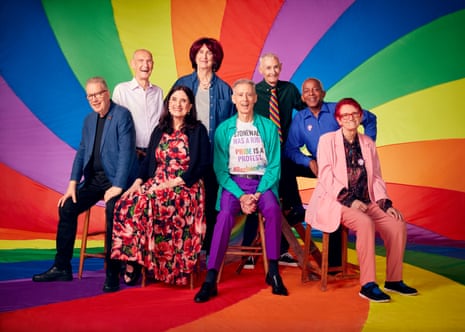









Comments (…)
Sign in or create your Guardian account to join the discussion